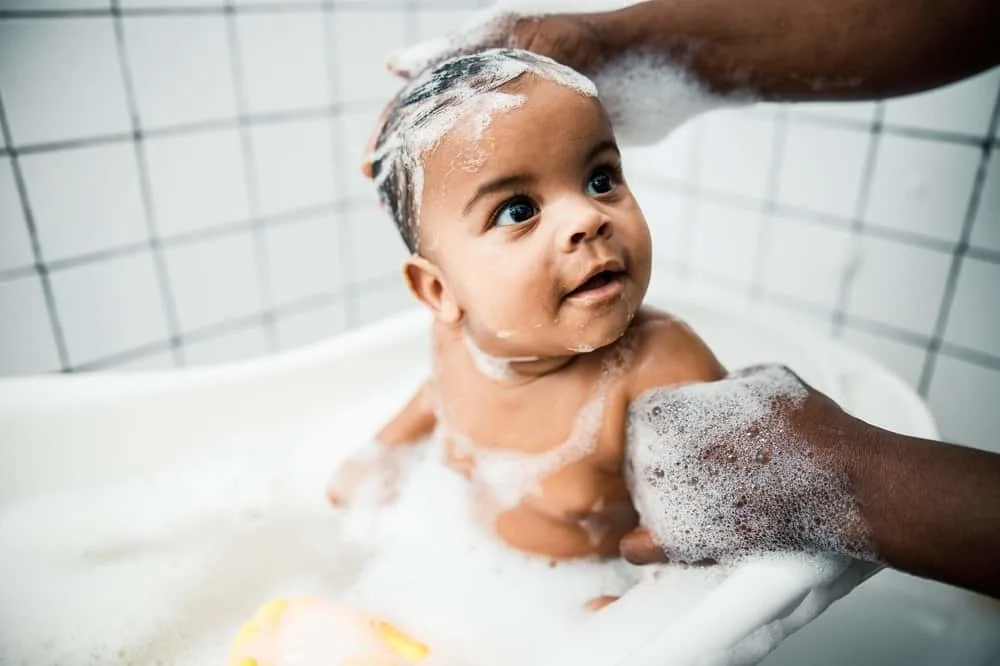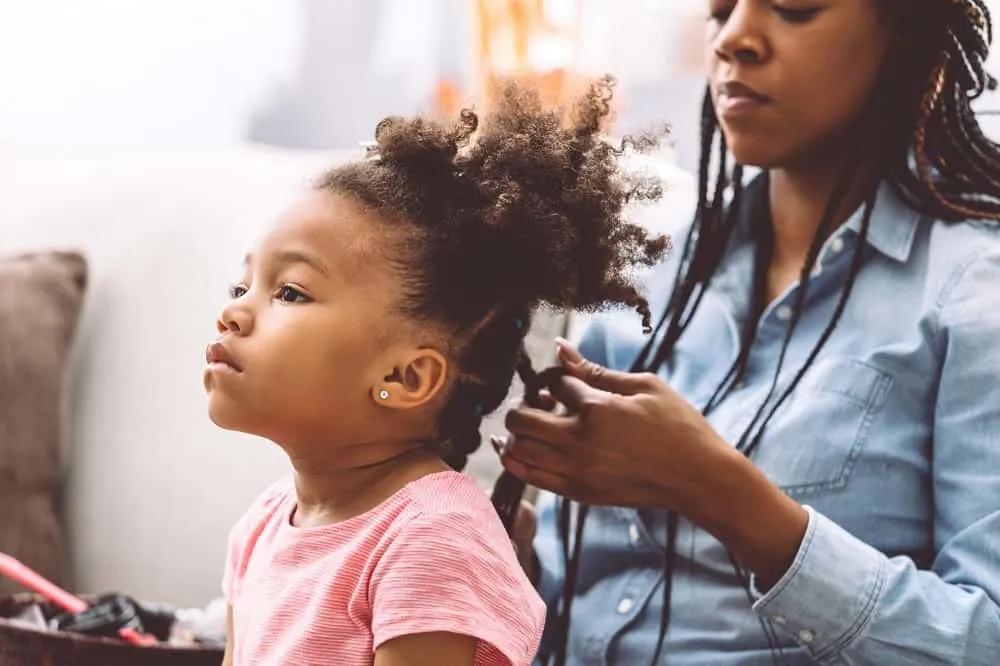With a little patience and lots of love, you can easily care for your baby’s hair and scalp. Because babies have delicate skin and hair, you should avoid washing their hair too often. For the best black baby hair care, you should use a conditioner to keep hair hydrated. You should also detangle hair after shampooing to maintain healthy, natural curls.
If you’re an African American, no matter you have a beautiful baby boy or girl, your baby’s hair needs special care. The hair texture will probably change as they grow older, so you may have to wash their hair more often. While completely normal, these hair texture changes may require you to spend some extra time detangling and styling.
Use these 15 afro baby hair care tips to help you develop a healthy hair washing routine for your baby.
Washing/Shampooing Your Baby’s Hair

Shampooing your baby’s hair helps keep both the hair and scalp clean and healthy.
#1. Wash Your Baby’s Hair No More Than Once a Week
Even though you may want to wash their hair more than once a week, washing your baby’s hair too often can strip it of the natural oils needed to maintain hydration and shine. Common signs of dehydrated hair include stiffness and dryness. Washing your baby’s hair too frequently can also irritate the scalp and cause a dry, itchy rash.
If your baby develops cradle cap, a common condition in babies three months or older, you should stick to a weekly hair washing schedule. Apply a cradle cream or a small amount of baby oil or virgin coconut oil over the area to loosen dry, flaky skin.
The cradle cap should clear up within a week. If not, you should schedule an appointment with your baby’s pediatrician.
#2. Use Gentle Baby Shampoos
Use sulfate-free baby shampoo to wash your baby’s hair. You can find these black baby hair care shampoos in most grocery stores or online. Don’t use the same shampoo and other hair care products that you and other family members use. Adult hair care products contain added chemicals that can cause scalp dryness.
#3. Try a Co-Wash To Prevent Dry Hair
If your baby’s hair and scalp remain dry and dehydrated, switch to a co-wash. Co-washes, or conditioner washes, are made primarily of conditioners and water, clean the scalp and hair without causing dryness or irritation. You can find co-washes in more grocery stores or pharmacies.
#4. Be Gentle When Shampooing Your Baby’s Hair
Gently massage your baby’s scalp to help keep your baby calm. Slowly work the shampoo through the hair to prevent breakage. Use warm water when washing your baby’s hair. Use your fingertips to massage shampoo into the hair and scalp.
Start at the top of your baby’s head and work your way down to their neck. Work slowly to keep the shampoo out of your baby’s eyes. After shampooing, use a cup to pour warm water over the hair slowly to rinse. Rinse thoroughly to make sure all the shampoo is gone. Enjoy this bonding time with your baby.
#5. Use a Wet Washcloth in Between Weekly Shampoos
To keep your baby’s hair and scalp clean between shampoos, use a damp washcloth, and gently wipe their hair and massage their scalp. Don’t pull on the hair; moisten it a little to remove excess oils.
As you can see, shampooing your baby’s hair doesn’t require many products. You may have to experiment with a few baby shampoos or co-washes until you find one that best suits your baby.
Your baby’s sensitivity to shampoos may change over time. Common signs of dryness and dehydration include dry, flaky skin, redness, and rash. Additional signs of dehydration include limp or dull hair; or hair that easily tangles.
Conditioning/Moisturizing
Conditioning and moisturizing your baby’s hair is the next step in promoting healthy hair growth.
#6. Apply a Moisturizing Conditioner After Shampooing
To maintain hydrated, shiny hair, apply a moisturizing conditioner made for babies every time you shampoo your baby’s hair. Failure to use a conditioning product could result in tangled, dehydrated hair.
#7. Apply Conditioner Evenly Throughout the Hair
Use a dime-sized amount of conditioner and apply it evenly using your fingertips. Pay special attention to hair ends as the ends tend to dry out first.
#8. Use Virgin Coconut Oil
If you don’t want to use a store-bought conditioner, or if the store-bought conditioner causes dryness or a scalp rash, apply a dime-sized amount of virgin coconut oil to your baby’s hair. Apply evenly over hair to lock in moisture and prevent dryness.
You will need to experiment to find the right black baby hair care conditioner for your baby. While it’s important to use a conditioning product to keep your baby’s hair hydrated, don’t use a conditioner that causes scalp irritation. Instead, use micellar water or natural oils found in your pantry to keep hair conditioned.
Detangling Your Baby’s Hair

Regularly detangling your baby’s hair helps keep hair looking and feeling healthy and shiny.
#9. Only Dentangle When Hair is Wet
If you need to detangle your baby’s hair, detangle it only when their hair is wet. Never try to detangle dry hair because you could cause breakage or pain. If you need to detangle your baby’s hair between shampoos, moisten the hair with a wet cloth, or apply a little virgin coconut oil before detangling to help prevent breakage.
#10. Use a Wide-Tooth Comb or Your Fingers
Detangle the hair by using a wide-toothed comb or your fingertips to gently separate hair strands and break up small clumps or knots. Don’t pull on your baby’s hair as you might upset your baby. If you encounter a large knot or a tangled mass of hair, work slowly to untangle as much hair as possible without causing pain.
Apply a little more oil or water to help loosen the hair. If this trick doesn’t work, consider waiting a day or two and then try again.
#11. Be Gentle and Patient
Detangling your baby’s hair can take some time depending on the texture and amount of knots. If your baby starts moving around too much or starts to cry, take a break and try again later.
Over time, you will get better at detangling your baby’s hair. Be patient and give yourself a break – you don’t have to detangle your baby’s hair every single day. When dealing with curly hair, remember that curly hair tends to become more tangled than straight hair, so take your time so you don’t break the curl.
Styling Your Baby’s Hair

Even though styling your baby’s hair is a lot of fun, you should avoid styling their hair every day as you could accidentally cause hair breakage. Save hair styling for picture taking purposes or for when your baby gets a little older.
#12. Keep Styling to a Minimum
When it comes to afro baby hair care, it’s best to wait until your baby is at least six months old before you start styling their hair with clips, beads, elastic bands, and other hair accessories. Clips and elastic bands can cause hair breakage because newborn hair is very fragile.
As your baby’s hair texture changes and becomes thicker, then you can use all kinds of decorative hair accessories to style.
#13. Use Covered Elastic Bands
If you need to style your baby’s hair for a special occasion, use covered or smooth elastic bands made specifically for hair use. Don’t use rubber bands as these tend to pull on the hair and cause breakage.
Also, rubber bands can get stuck in your baby’s hair and cause pain when you remove them. In addition to damaging your baby’s hair, clips and hair accessories can be a choking hazard if your baby accidentally puts one in their mouth or up their nose.
If you want to style your newborn’s hair, consider using a thin, satin headband instead.
Normal Hair Changes
Your baby’s hair will probably change as they get older.
#14. Don’t Worry About Any Changes in Hair Texture
As your baby gets older, their hair texture may change. This is perfectly normal; and not something you should worry too much about. You may need to increase or decrease hair washing to maintain hydration during this time.
#15. Don’t Panic if Your Baby Loses Hair or Has a Bald Spot
Losing some hair or developing a bald spot is normal as your baby grows. Over time, your baby’s hair will grow and become thicker and fuller. If concerned about bald spots, swap out your baby’s cotton pillowcase for a satin pillowcase. Cotton material can pull on the hair and cause breakage, while lighter satin material does not.
Final Thoughts
You can do this! Taking care of a newborn’s hair and scalp may require a little effort on your part, but once you find the right afro baby hair care products and create a routine, you and your baby can enjoy those weekly bath times.
With so many black baby hair care products on the market today, you should have no problem finding the right ones to suit the needs of your baby.
